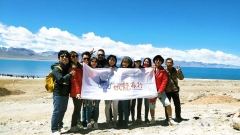Tibet, known as the “Roof of the World,” is famous for its high mountains, sacred monasteries, and clear lakes. Its environment and culture are fragile, so eco-tourism is important to protect them. By traveling responsibly, visitors can enjoy Tibet’s beauty while helping preserve it for future generations.
Why Eco-Tourism Matters in Tibet
Tibet’s unique environment is extremely vulnerable to human impact. High-altitude grasslands, rare wildlife, and glacier-fed rivers can be easily disturbed by overdevelopment or careless travel. At the same time, Tibetan culture, with its strong Buddhist values and nomadic traditions, deserves respect and preservation. Practicing eco-tourism not only minimizes negative impacts but also supports local communities, empowering them to maintain their way of life.

Sustainable Travel Tips for Tibet
1. Respect Local Culture and Traditions
Tibetan Buddhism is deeply woven into daily life. Always be mindful when visiting monasteries, temples, and sacred mountains. Dress modestly, walk clockwise around religious sites, and avoid photographing monks or locals without permission. Learning a few basic Tibetan greetings can also show respect and create meaningful connections.
2. Choose Eco-Friendly Accommodation
Many guesthouses and lodges in Tibet are run by local families, offering more sustainable and culturally immersive stays. Some eco-lodges use solar power, recycle waste, and source food locally. By choosing these accommodations, you support businesses that prioritize the environment and the local economy.
3. Travel Light and Reduce Waste
Plastic waste is a growing issue in remote areas. Bring a reusable water bottle, shopping bag, and utensils to avoid single-use plastics. Travelers can also carry small biodegradable soaps and toiletries to minimize pollution in fragile ecosystems.
4. Support Local Communities
When buying souvenirs, choose locally made handicrafts instead of mass-produced imports. Wool products, handmade jewelry, and traditional thangka paintings are not only beautiful but also help sustain Tibetan artisans. Eating in small local restaurants rather than large chains also spreads your spending more directly to the community.
5. Use Responsible Transportation
Where possible, consider overland travel instead of domestic flights, which have a larger carbon footprint. While traveling by car or bus may take longer, it offers opportunities to experience breathtaking landscapes and interact with locals along the way. Sharing transport with other travelers is also a more eco-conscious choice.
6. Respect Wildlife and Natural Areas
Tibet is home to rare animals such as wild yaks, Tibetan antelopes, and black-necked cranes. Keep a safe distance when observing wildlife and avoid leaving food or litter behind. Stick to established trails during treks to reduce erosion and prevent damage to delicate alpine vegetation.

Best Practices for a Deeper Eco-Travel Experience
Eco-tourism is not only about minimizing harm—it’s about creating a positive impact. Travelers can:
-
Participate in community-led cultural tours or workshops.
-
Volunteer with local conservation projects.
-
Learn about Tibetan medicine, cuisine, and art in ways that directly support locals.
By doing so, you go beyond sightseeing and become part of a cultural exchange that benefits both you and the Tibetan people.
Conclusion
Tibet’s beauty lies not just in its towering peaks and sacred sites, but also in the harmony between its people, culture, and nature. Practicing eco-tourism ensures that this harmony is preserved. By traveling respectfully, supporting local communities, and minimizing environmental impact, you can make your trip more meaningful while helping Tibet remain the breathtaking “Roof of the World” for generations to come.












